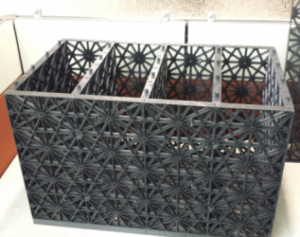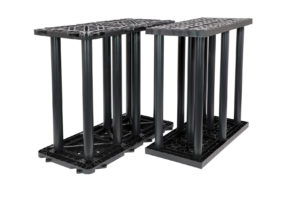What Makes StormTank Modules Different From Other “Crates”?

One of the biggest misconceptions in the stormwater management industry is that all box structures are the same. This couldn’t be further from the truth. There are actually two different types of underground stormwater storage box structures: the internal-walled “crate” (Image 1) and the column-supported product. Brentwood’s StormTank Modules are one of the few products that are designed as a columnar structure (Image 2).


So, does shape make a difference in terms of system performance and accessibility? Yes! Shape plays a role in load resistance, cleanability, connections, and cost:
Load Resistance
In general, when a load is applied to the top or the side of the product, it is transferred through a connection to the support member that then transfers the load to the base.
With internal-walled products, the interior and exterior walls will transfer the vertical load to the base, and compression forces from lateral loads will be transferred from the exterior walls to the internal walls. These internal walls are connected to the outer walls and base by pins, which have small engagement areas. This makes the pins susceptible to shearing if high loads or inadequate engagement occurs and can result in system failure.
Column-based systems function similarly by transferring vertical loads through a socket to the column and through the column to the base. Additionally, these structures utilize panels around the perimeter to resist lateral forces, providing resistance to lateral pressure. And they are doubly enforced: as the lateral forces increase to a level above the wall’s strength, the wall will deflect and engage the column to provide the needed resistance.
Cleanability
Internal-walled systems can limit the ability for material to move freely through a stormwater storage system and can cause increased buildup of debris. This is because once the debris enters the system and gets caught on a wall, additional debris will accumulate around it. This buildup of larger material can prevent the system from properly retaining runoff, causing the runoff to back up into the storm sewer and increasing necessary maintenance.
In products without internal walls, runoff and debris can flow freely through the system. This is beneficial because debris can pass through the system without clogging the connections, and it also reduces the likelihood of backups and maintenance concerns.
Connections
When it comes to connections, we need to consider two different types: inlet and outlet connections as well as observation and cleanout connections.
Inlet & Outlet: In this regard, internal-walled structures limit the potential pipe sizes that can be connected to the product because it has very limited space on the sides due to the internal walls – which are typically less than 12” apart. Space is also limited on the shorter ends of the product, which are typically less than 18” wide. Therefore, pipes larger than these diameters cannot directly connect to the product and must be abutted to the uncut panel. This can lead to pipe clogging, settling, and even damage to the panel.
This problem is reduced with column-supported structures as the panels freely span the height of the product. To accommodate larger pipe diameters, an opening can span two adjoining stormwater storage Modules while retaining their structural strength. Or, if the products are abutted against a catch basin for direct flow, the side panels can be removed. These connection options prevent flow point clogging and backups into the storm sewer system.
Observation & Cleanout: These are added to the top of the product. Both internal-walled and column-based products have diameter limitations, which are determined by the distance between the walls or the columns. However, column-based systems typically have greater spacing to allow for larger connections and greater access for cleanability. Because of the openness of the columnar systems, you can also see greater distances with a camera than you would be able to in an internal-walled system.
Cost
Last but not least, the cost difference is important to note. Both the number of external walls and the total height of the stormwater storage system affect the bottom line. Utilizing an internal-walled product means that changing the shape or alignment of the system will not affect the cost because external panels are built into the price for each piece. The drawback of this pricing model is that you pay for all the internal panels, so there are no price breaks or options for optimizing cost based on the layout. These products become more cost-effective as the ratio of system area to perimeter increases.
Column-based products are the opposite. For example, if we consider two column-based systems with the same storage capacity, a long and narrow shape will require more external panels, and therefore, will have a higher cost per unit storage. But a more square-shaped system would have more internal area with a smaller perimeter, resulting in fewer external panels and lower cost. This design allows for layout flexibility, which can help you to save money.